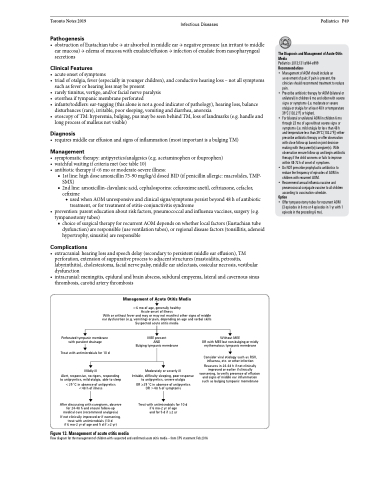Page 1083 - TNFlipTest
P. 1083
Toronto Notes 2019 Infectious Diseases
Pathogenesis
• obstructionofEustachiantube→airabsorbedinmiddleear→negativepressure(anirritanttomiddle ear mucosa) → edema of mucosa with exudate/effusion → infection of exudate from nasopharyngeal secretions
Clinical Features
• acuteonsetofsymptoms
• triadofotalgia,fever(especiallyinyoungerchildren),andconductivehearingloss–notallsymptoms
such as fever or hearing loss may be present
• rarely tinnitus, vertigo, and/or facial nerve paralysis
• otorrhea if tympanic membrane perforated
• infants/toddlers:ear-tugging(thisaloneisnotagoodindicatorofpathology),hearingloss,balance
disturbances (rare), irritable, poor sleeping, vomiting and diarrhea, anorexia
• otoscopyofTM:hyperemia,bulging,pusmaybeseenbehindTM,lossoflandmarks(e.g.handleand
long process of malleus not visible)
Diagnosis
• requiresmiddleeareffusionandsignsofinflammation(mostimportantisabulgingTM)
Management
• symptomatictherapy:antipyretics/analgesics(e.g.acetaminophenoribuprophen) • watchfulwaitingifcriteriamet(seetable10)
• antibiotictherapyif<6moormoderate-severeillness:
■ 1st line: high dose amoxicillin 75-90 mg/kg/d dosed BID (if penicillin allergic: macrolides, TMP- SMX)
■ 2nd line: amoxicillin-clavulanic acid, cephalosporins: cefuroxime axetil, ceftriaxone, cefaclor, cefixime
◆ used when AOM unresponsive and clinical signs/symptoms persist beyond 48 h of antibiotic treatment, or for treatment of otitis-conjunctivitis syndrome
• prevention:parenteducationaboutriskfactors,pneumococcalandinfluenzavaccines,surgery(e.g. tympanostomy tubes)
■ choice of surgical therapy for recurrent AOM depends on whether local factors (Eustachian tube dysfunction) are responsible (use ventilation tubes), or regional disease factors (tonsillitis, adenoid hypertrophy, sinusitis) are responsible
Complications
• extracranial:hearinglossandspeechdelay(secondarytopersistentmiddleeareffusion),TM perforation, extension of suppurative process to adjacent structures (mastoiditis, petrositis, labyrinthitis), cholesteatoma, facial nerve palsy, middle ear atelectasis, ossicular necrosis, vestibular dysfunction
• intracranial:meningitis,epiduralandbrainabscess,subduralempyema,lateralandcavernoussinus thrombosis, carotid artery thrombosis
Management of Acute Otitis Media
>6 mo of age, generally healthy
Acute onset of illness
With or without fever and may or may not manifest other signs of middle ear dysfunction (e.g. vomiting) or pain, depending on age and verbal skills Suspected acute otitis media
Pediatrics P49
The Diagnosis and Management of Acute Otitis Media
Pediatrics 2013;131:e964-e999 Recommendations
• ManagementofAOMshouldincludean assessment of pain; if pain is present, the clinician should recommend treatment to reduce pain.
• Prescribe antibiotic therapy for AOM (bilateral or unilateral) in children 6 mo and older with severe signs or symptoms (i.e. moderate or severe otalgia or otalgia for at least 48 h or temperature 39°C [102.2°F] or higher).
• ForbilateralorunilateralAOMinchildren6mo through 23 mo of age without severe signs or symptoms (i.e. mild otalgia for less than 48 h and temperature less than 39°C [102.2°F]) either prescribe antibiotic therapy or offer observation with close follow-up based on joint decision- making with the parent(s)/caregiver(s). With observation ensure follow-up and begin antibiotic therapy if the child worsens or fails to improve within 48-72 h of onset of symptoms.
• DoNOTprescribeprophylacticantibioticsto reduce the frequency of episodes of AOM in children with recurrent AOM.
• Recommend annual influenza vaccine and pneumococcal conjugate vaccine to all children according to vaccination schedule.
Option
• OffertympanostomytubesforrecurrentAOM (3episodesin6moor4episodesin1yrwith1 episodeinthepreceding6mo).
Perforated tympanic membrane with purulent drainage
Treat with antimicrobials for 10 d
Mildly ill
Alert, responsive, no rigors, responding to antipyretics, mild otalgia, able to sleep <39˚C in absence of antipyretics <48 h of illness
After discussing with caregivers, observe for 24-48 h and ensure follow-up medical care (recommned analgesia)
If not clinically improved or if worsening, treat with antimicrobials (10 d
if 6 mo-2 yr of age and 5 d if ≥2 yr)
Figure 13. Management of acute otitis media
MEE present
AND
Bulging tympanic membrane
Moderately or severly ill Irritable, difficulty sleeping, poor response to antipyretics, severe otalgia
OR ≥39˚C in absence of antipyretics OR >48 h of symptoms
Treat with antimicrobials for 10 d if 6 mo-2 yr of age
and for 5 d if ≥2 yr
Without MEE
OR with MEE but non-bulging or midly erythematous tympanic membrane
Consider viral etiology such as RSV, influenza, etc. or other infection Reassess in 24-48 h if not clinically improved or earlier if clinically worsening, to verify presence of effusion and signs of middle ear inflammation such as bulging tympanic memebrane
Flow diagram for the management of children with suspected and confirmed acute otitis media – from CPS statement Feb 2016


